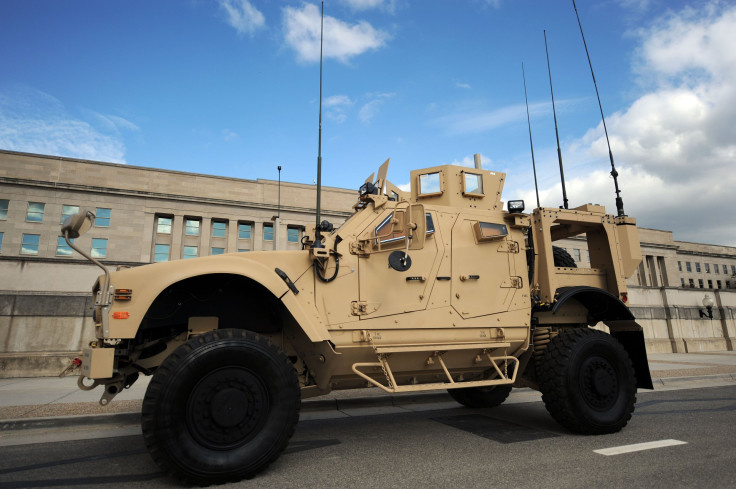'Ukrainian Militants' Entered Russia Using US-Made Armored Vehicles, Attacked Russian Facilities

KEY POINTS
- At least three U.S. military vehicles were used by pro-Ukrainian fighters inside Russia, reports say
- Two U.S.-made MRAP vehicles were allegedly captured by Russian forces
- A U.S. State Department spokesman insisted the U.S. did not encourage strikes inside of Russia
Volunteer fighters sympathetic to Ukraine appeared to use at least three U.S.-made armored vehicles during their incursion into Russia Monday, according to a report.
The New York Times obtained pictures and photos showing the armored vehicles, at least two of which were allegedly captured by Russian forces.
The military vehicles used by pro-Ukraine, anti-Putin fighters were identified as the International MaxxPros model of the Mine-Resistant Ambush Protected (MRAP) vehicles, which were first built for the U.S. forces in Iraq and Afghanistan.
While many countries have purchased and used MRAPs, the U.S. is the only country known to have specifically supplied MRAPs to Ukraine.
Matthew Miller, a U.S. State Department spokesman, said they are "skeptical at this time of the veracity of these reports" of U.S. military vehicles allegedly being used by pro-Ukrainian fighters.
Miller insisted that the U.S. did not "encourage or enable strikes inside of Russia" but added that "it is up to Ukraine to decide how to conduct this war."
Meanwhile, the incursion led by anti-Russian forces aligned with Ukraine marked its second day on Tuesday.
The Times said there were reports of an explosion at a defense factory and skirmishes at a crossing in the Russian region of Belgorod, which shares a border with Ukraine.
A group called the Free Russia Legion claimed responsibility for the incursions. The volunteer unit is made up of Russians who took up arms for Ukraine and operates under the umbrella of Ukraine's International Legion, forces overseen by Ukrainian officers, according to the publication.
Ilya Ponomarev, an exiled former member of the Russian parliament who described himself as the political representative of the Free Russia Legion, told the Times via phone call that their campaign aims to force the Russian military to divert its troops fighting in Ukraine and destabilize Russian President Vladimir Putin's government.
"We think now they need to reconsider and deploy more forces all along the Ukrainian border," Ponomarev said.
Ponomarev added that the armed group had captured about a dozen Russian border guards, but NYT and the International Business Times could not independently verify his claim.
Despite Ukraine's denial of direct involvement in the incursion, a senior Ukrainian official, who spoke anonymously to reveal details about the situation inside Russia, told the New York Times that the Ukrainian military was acting in support of the volunteer fighters and protecting the country's border in case of a Russian counterattack.
The senior official added that no Ukrainian fighters entered Russian territory.
Meanwhile, the Kremlin said it was deeply concerned about the incursion of pro-Ukrainian fighters in Belgorod.
"Of course, what happened yesterday is deeply concerning, it once again confirms that Ukrainian militants continue their activities against our country," Kremlin spokesperson Dmitry Peskov told reporters, Russian state-run news outlet TASS reported.
Without providing details, Peskov claimed that the anti-Russian fighters' ethnicity was "Ukrainian."
"There are many ethnic Russians living in Ukraine, but still, [the saboteurs that intruded into Russian territory] are Ukrainian militants. This is what matters," Peskov said.

© Copyright IBTimes 2024. All rights reserved.






















